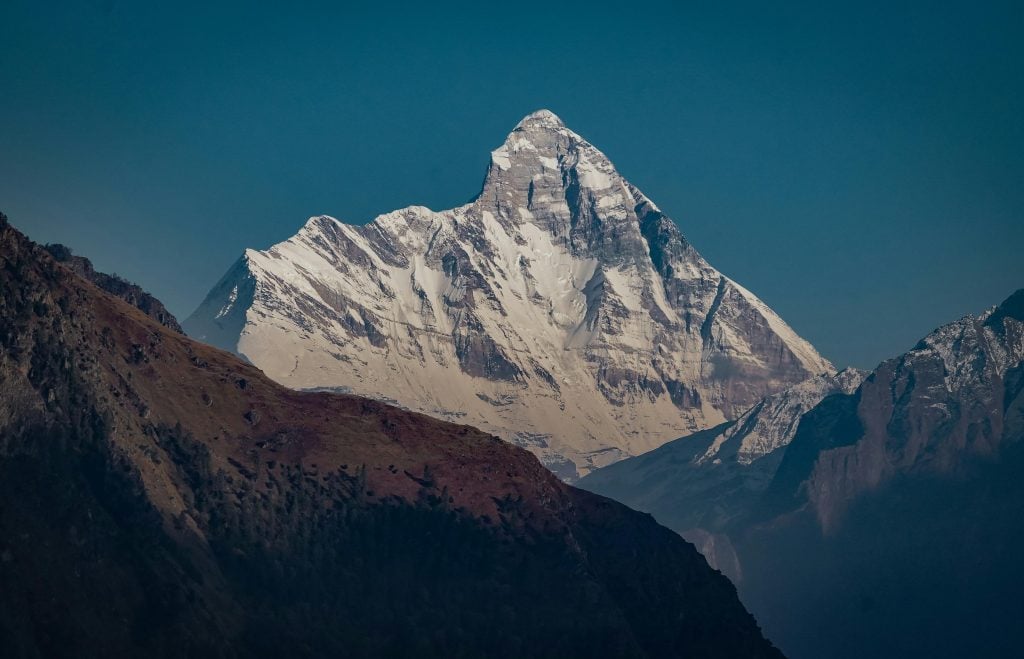Mount Nanda Devi : The Mystery and Majesty
Nanda Devi, India’s second-highest peak, captivates not only with its towering height but also with its mysterious aura. Unlike many other mountains, Nanda Devi emanates a unique, sacred energy that reflects the mysticism of the Himalayas. Located in the state of Uttarakhand, India, this impressive peak stands at 7,816 meters, showcasing nature’s overwhelming power. Mount Nanda Devi : The Mystery and Majesty
Legends and Cultural Significance
In Hindu mythology, Nanda Devi holds a special place. Named after the Hindu goddess Nanda Devi, this mountain is considered sacred by the local people, who perform various traditional rituals in its honor. According to local beliefs, Nanda Devi resides in these high Himalayan altitudes as a guardian of the mountain’s beauty. Rooted in spiritual lore, this mountain stands as a testament to the community’s profound reverence for their traditions and deities.
Nature and Ecosystem: A Biosphere Reserve of Rich Biodiversity
In addition to its breathtaking landscape, Nanda Devi hosts a unique and fragile ecosystem. Designated as a UNESCO World Biosphere Reserve in 1982, the Nanda Devi National Park is home to endangered species and rare flora. With alpine vegetation, pine forests, colorful wildflowers, and diverse wildlife, this region is a sanctuary for nature enthusiasts and biologists alike.
Mountaineering History and Challenges
Nanda Devi holds a notable place in mountaineering history. In 1936, Eric Shipton and Bill Tilman completed the first ascent, a feat previously deemed impossible. Its natural obstacles and challenges have made Nanda Devi a revered destination for climbers. However, to protect its delicate ecosystem, the mountain was closed to expeditions in 1983, with restricted tourism policies now in place.
Nanda Devi’s Unique Landscape and Spiritual Pull
Nanda Devi carries a distinctive energy that sets it apart from other Himalayan peaks. The atmosphere created by the winds at its summit, the surrounding mountains, and its snow-covered slopes make it feel like a sacred temple of nature. Visitors often describe their journey here not as a simple trek but as a spiritual experience. The first rays of sunlight hitting Nanda Devi’s peak create a breathtaking moment, as if time itself stands still.
Conclusion: More Than Just a Mountain
Nanda Devi is more than just a mountain; it’s a symbol, a story, and a tradition. Those who tread its foothills feel the strength and fragility of nature. This peak is a reminder of humanity’s responsibility to respect and preserve the natural world. A journey to Nanda Devi goes beyond an ordinary mountain expedition; it’s an experience that transforms the soul.
What are the basic facts about Nanda Devi Mountain?
Nanda Devi Mountain is located in the Garhwal region of the Himalayas in Uttarakhand, India. Standing at 7,816 meters, it is the second-highest mountain in India. The summit was first reached by British climbers in 1936.
Why is Nanda Devi Mountain significant?
Nanda Devi is considered a sacred mountain in Hindu belief, and the surrounding Nanda Devi National Park is listed as a UNESCO World Heritage Site. The region is also significant for its unique biodiversity.
Why are climbing activities restricted on Nanda Devi?
Climbing to the summit of Nanda Devi has been banned by the Indian government since 1983 to protect the fragile ecosystem. The area is home to rare plant and animal species, so restrictions help preserve the natural environment.
Who were the first climbers to reach the summit?
The first successful ascent of Nanda Devi was made in 1936 by British mountaineers Bill Tilman and Noel Odell. At that time, it was considered a major accomplishment.
Is it possible to hike or camp around the mountain?
Yes, trekking and hiking are allowed in Nanda Devi National Park, but due to conservation efforts and climbing restrictions, only certain trails and areas are accessible for these activities.
What is the ecosystem like around Nanda Devi Mountain?
The Nanda Devi region hosts a wide range of rare plants and animals, including the Himalayan black bear, musk deer, blue sheep, and various endemic plant species. This biodiversity and the presence of unique species are among the reasons for its conservation status.
The Highest Mountains in China
Mount Nanda Devi : In Pursuit of a Mysterious Peak on Google Maps and Photos





